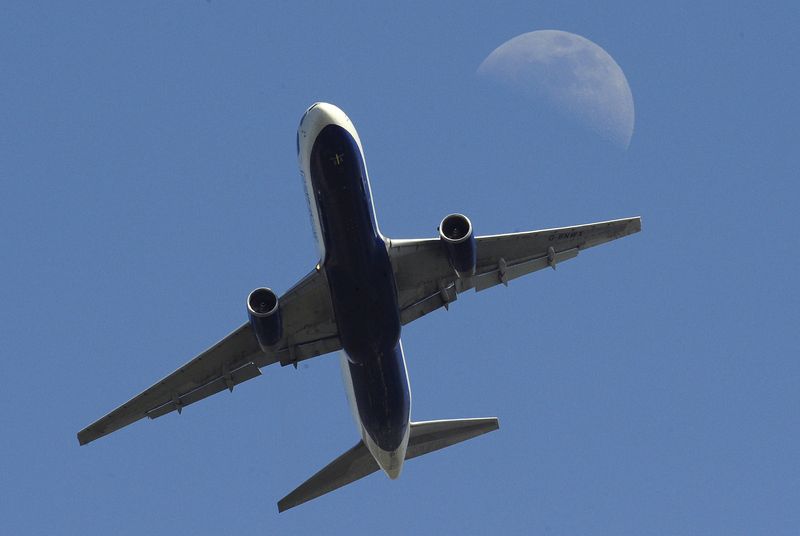(Reuters) - Higher oil prices amid turmoil in the Middle East are increasing prices of jet fuel, which accounts for a big portion of airlines' costs.
Brent crude oil almost hit $94 per barrel shortly after the Hamas attack in Israel on Oct. 7. It has since eased to around $84.
Spot Northwest European jet fuel prices were at $914 per metric ton, or around $116 per barrel, on Thursday. That compares to a peak of over $128 per barrel in the week following the assault, and an all-time high of around $186 in June 2022 after Russia's invasion of Ukraine.
Some airlines use futures and options to hedge against price increases. They also try to hedge against value changes in the U.S. dollar, in which jet fuel is priced.
Here is how European airlines are hedged heading into 2024:
AIR FRANCE-KLM:
The CEO of the Franco-Dutch airline said on Oct. 27 it was "quite sufficiently hedged" for six months ahead.
The group has hedged 70% of its jet fuel consumption for the fourth quarter of 2023 and 64% for the first quarter of 2024, for $129.87 and $123.80 per barrel, respectively.
EASYJET:
The British discount airline said on Nov. 28 it had hedged 76% of its fuel needs for the first half of 2024 and 51% for the second, at an average cost of $109.75 and $104.18 per barrel, respectively. This was slightly higher than the $109.62 and $104.05 reported in October.
It has 76% of the dollars it expects to need in the first half of the year, bought at $1.22 per pound, and 53% for the second half at $1.24 per pound.
FINNAIR:
The Finnish carrier, which said in October its quarterly operating result was hurt by higher fuel prices, hedges its fuel purchases for 12 months on a rolling basis.
It has covered 159,000 tons of fuel for the first quarter at an average price of $116.20 per barrel, 126,000 tons for the second at $109.87 per barrel, and 87,000 tons for the third at $118.23 per barrel. At the end of September, this amounted to over 50% of Finnair's fuel purchases for the next 12 months, a company spokesperson told Reuters.
IAG (LON:ICAG):
The owner of British Airways and Iberia said in July it was 58% hedged for the first quarter, 49% for the second, 39% for the third, and 32% for the fourth quarter of 2024. Including currency risk, the group was hedged at $103.16 per barrel for the first and third quarters, and at $102.53 for the second and fourth quarters.
On Oct. 27, the group's CEO said IAG was well-hedged on jet fuel for the first and second quarters.
ICELANDAIR:
The Icelandic carrier said in October it had 20,500 tons of fuel hedged for passenger flights in the first quarter, or 33% of estimated total usage at $102.66 per barrel. It has hedged 26% of second-quarter usage at 26,500 tons for $106.33 per barrel, and 5% of third-quarter usage at 7,000 tons for $106.58 per barrel.
LUFTHANSA:
The German carrier said on Nov. 2 its "high hedge ratio" meant it was well protected against rising oil prices. Lufthansa (ETR:LHAG) has hedged 74% of the fuel it expects to need for 2024 at an average price of $120.38 per barrel.
NORWEGIAN AIR:
The Norwegian carrier said on Nov. 2 it had hedged about 35% of its fuel needs for 2024 "at levels considerably below current forward prices". As of October, it had hedged 63,100 tons of jet fuel at $97.22 per barrel for the first half and 91,300 tons at $99.24 per barrel for the second half of 2024.
RYANAIR:
The Irish carrier said on Nov. 6 it had secured about 85% of its fuel requirements for 2024 at $89 per barrel, and over 50% for 2025 at $79 per barrel.
The airline has bought more than 90% of the dollars it expects to need for operating expenses next year at $1.08 per euro, and a half of those needed for 2025 at $1.12 per euro, it said.
SAS:
The biggest Scandinavian carrier said on Nov. 30 it had not hedged any of its fuel consumption for the next year. At the end of October, SAS had hedged 41% of the U.S. dollars it expects to use in the next 12 months. In terms of Norwegian crowns, SAS's largest surplus currency, 42% was hedged for the next year.
WIZZ AIR:
The Hungarian budget carrier had as of Nov. 6 hedged 70% of its 2024 fuel needs at a price ranging from $102.66 to $117.85 per barrel, and 38% of 2025 needs for $94.56 to $108.10 per barrel.

It has bought 69% of the dollars it expects to need for jet fuel in 2024 at $1.07 to $1.11 per euro, and 32% for 2025 at $1.09 to $1.14 per euro.
(1 metric ton of jet fuel = 7.9 barrels)